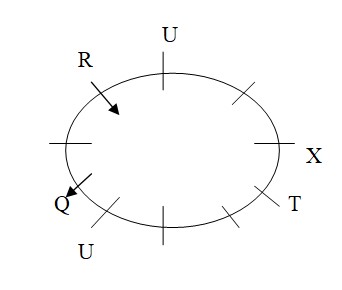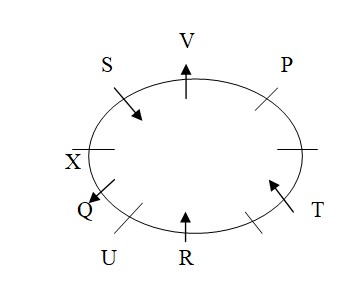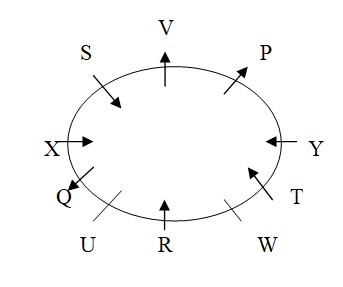Question
Who sits opposite to
R? Answer the questions based on the information given below. Ten persons P, Q, R, S, T, U, V, W, X and Y sit around a circular table such that four of them face outside while others face towards the centre. No two persons with names starting with consecutive alphabets are immediate neighbors of each other. T sits 4th to the left of Q, who faces outside. U sits immediate left of R, who faces towards the centre. U and Y face same direction as X. X doesn’t face outside. Two persons sit between X and P, who doesn’t sit 2nd to the left of T. S and V sits immediate left of each other. X sits 3rd to the left of R. S and T face same direction. Y doesn’t sit adjacent to R. V and W face same direction as P.Solution
T sits 4th to the left of Q, who faces outside. U sits immediate left of R, who faces towards the centre. X sits 3rd to the left of R. So, T sits either 2nd to the right of R or 4th to the left of R. Also, X sits either immediate right of Q or 5th to the left of Q. Case I: T sits 2nd to the right of R:  Case II: T sits 4th to the left of R:
Case II: T sits 4th to the left of R:  Two persons sit between X and P, who doesn’t sit 2nd to the left of T. S and V sits immediate left of each other, this is not possible in case II, so case II is rejected. S and T face same direction. So, S and T face towards the centre and V faces outside.
Two persons sit between X and P, who doesn’t sit 2nd to the left of T. S and V sits immediate left of each other, this is not possible in case II, so case II is rejected. S and T face same direction. So, S and T face towards the centre and V faces outside.  Y doesn’t sit adjacent to R. V and W face same direction as P. U and Y face same direction as X. X doesn’t face outside. So, W faces outside and sits adjacent to R and Y sits immediate right of T. Also, U and Y face towards the centre and P face outside. The final seating arrangement is given below:
Y doesn’t sit adjacent to R. V and W face same direction as P. U and Y face same direction as X. X doesn’t face outside. So, W faces outside and sits adjacent to R and Y sits immediate right of T. Also, U and Y face towards the centre and P face outside. The final seating arrangement is given below: 
If the indorser signs his name and adds a direction to pay the amount mentioned in the instrument to a specified person, the indorsement is said to be
Appeal from the order of State Commission shall be filed within_____________.
Where the court refers the parties to the suit to the mode of settlement of dispute referred to section 89 of C.P.C. plaintiff shall be entitled to ref...
Specific Performance of a contract does not mean_______________
Under Section 24 of the Bharatiya Sakshya Adhiniyam, 2023, regarding confessions by co-accused in joint trials, which of the following statements is MOS...
As per section 4 of the RTI Act every public authority shall publish within one hundred and twenty days from the enactment of the Act the______________...
Which of the following is considered an "existing Unit" under the SEZ Act?
If any Court has reason to believe (whether after taking evidence or not) that any person against whom a warrant has been issued by it has absconded or ...
The Stakeholders Relationship Committee can be constituted by the Board of which Companies, under the Companies Act, 2013?
Section 151 of the Code of Civil Procedure deals with:
Relevant for Exams:


